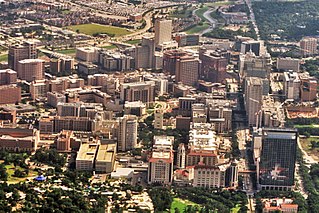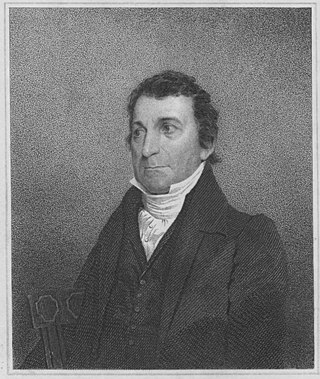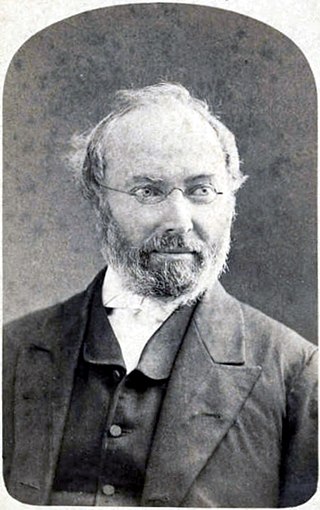History
Soule University began as 'Chappell Hill Institute', a private preparatory school informally established during or before 1850. The school was chartered by the Texas Legislature in 1852 as a non-denominational preparatory school under the name Chappell Hill Male and Female Institute. That same year, Philander S. Ruter, son of Methodist missionary Martin Ruter, was elected president of the school. In 1854, Chappell Hill's charter was amended to affiliate the school with the Methodist Church. [2] [3]
The Methodists had been seeking a replacement for the financially unstable and scandal-ridden Rutersville College and identified Chappell Hill as the site for a new institution of higher education. The Methodist Church took great pains to ensure the new school was under the authority of the Methodist Church, attributing some of Rutersville College's failures to the school's independent legal status. [3]
In 1856, Soule University was chartered as a Methodist-affiliated university and all students in the male department of Chappell Hill Male and Female Institute were transferred into Soule's preparatory department. Classes began in September 1856 with seven academic departments. Originally located in the former buildings of Chappell Hill Male and Female Institute, the university built a new building on donated land in 1858 to separate itself from Chappell Hill Female College. [3]
Soule closed in 1861 at the start of the American Civil War with most students joining the Confederate States Army. During the war, the Confederacy used Soule's campus as a hospital. When the university reopened in 1865, [3] the classrooms and library had been badly damaged and most of the school equipment had been lost. The economy of the Chappell Hill area was devastated after the war, limiting the university's sources of funding. When an outbreak of yellow fever in Chappell Hill grew into two epidemics, Soule's student population dropped precipitously and never recovered. [1] [3]
In an effort to broaden the university's reach, Soule opened Texas' first medical school in 1865. The school, located in Galveston, was self-sustaining and eventually severed connections with Soule to become the Texas Medical College and Hospital, now the University of Texas Medical Branch. [3]
The epidemics combined with financial troubles led Soule University president Francis Asbury Mood to petition the Methodist Church to found a new “central university for Methodism” with the full backing of all five Methodist conferences in Texas. The resulting school, originally named Texas University but chartered as Southwestern University, assumed the role for which the Methodist Church had founded Soule. The Church declared Southwestern to be Soule's successor in 1873 and the Texas Legislature transferred Soule's charter to Southwestern in 1875. [3]
Local supporters in Chappell Hill kept Soule open for over a decade after the school's charter was transferred to Southwestern. By 1873, Soule had paid off all debts and was seeking to start a law school in another city, despite recently releasing its neglected medical school in Galveston. The university was renamed Soule College in 1878, but enrollment continued to decrease until only 29 students remained in 1887. In that year, Soule approached Southwestern with a proposal that Soule become a correlated school of Southwestern. The proposal was rejected. [3] Soule University closed in 1887.
Soule's campus was used by Chappell Hill Female College until it closed in 1912. [2]

The Texas Medical Center (TMC) is a 2.1-square-mile (5.4 km2) medical district and neighborhood in south-central Houston, Texas, United States, immediately south of the Museum District and west of Texas State Highway 288. Over 60 medical institutions, largely concentrated in a triangular area between Brays Bayou, Rice University, and Hermann Park, are members of the Texas Medical Center Corporation—a non-profit umbrella organization—which constitutes the largest medical complex in the world. The TMC has an extremely high density of clinical facilities for patient care, basic science, and translational research.

Southwestern University is a private liberal arts college in Georgetown, Texas. Formed in 1873 from a revival of collegiate charters granted in 1840, Southwestern is the oldest college or university in Texas. Southwestern offers 40 bachelor's degrees in the arts, sciences, fine arts, and music as well as interdisciplinary and pre-professional programs. It is accredited by the Southern Association of Colleges and Schools and the National Association of Schools of Music and historically affiliated with the United Methodist Church.

Huston–Tillotson University (HT) is a private historically black university in Austin, Texas. Established in 1875, Huston–Tillotson University was the first institution of higher learning in Austin. The university is affiliated with the United Methodist Church, the United Church of Christ, and the United Negro College Fund. Huston–Tillotson University awards bachelor's degrees in business, education, the humanities, natural sciences, social sciences, science, and technology and a master's degree in educational leadership. The university also offers alternative teacher certification and academic programs for undergraduates interested in pursuing post-graduate degrees in law and medicine.

Chappell Hill is an unincorporated community in the eastern portion of Washington County, Texas, United States. It is located inside Stephen F. Austin's original colony, and the land is some of the oldest Anglo-settled in the state. According to the Handbook of Texas, the community had a population of 600 in 2000. It is located within the Greater Houston metropolitan area.
The following is a timeline of women's colleges in the United States. These are institutions of higher education in the United States whose student population comprises exclusively, or almost exclusively, women. They are often liberal arts colleges. There are approximately 35 active women's colleges in the U.S. as of 2021.

Rutersville College, was a coeducational college located in the unincorporated community of Rutersville in Fayette County, Texas, United States. Chartered under the Republic of Texas in 1840, Rutersville College was Texas's first institution of higher education. It was named for Methodist missionary and educator Martin Ruter, who wrote the school's charter and raised funds to establish the institution, which he originally intended to be named Bastrop College. The Congress of Texas initially rejected the school's charter because it affiliated the school with the Methodist Church. Ruter died two years before the school finally opened under a revised charter excluding a religious affiliation.
Walden University was a historically black college in Nashville, Tennessee. It was founded in 1865 by missionaries from the Northern United States on behalf of the Methodist Church to serve freedmen. Known as Central Tennessee College from 1865 to 1900, Walden University provided education and professional training to African Americans until 1925. Meharry Medical College, established as one of Walden's departments in 1876, was the first medical school in the South for African Americans. In 1915, it was chartered separately and became a separate institution. It is one of the constellation of colleges in Nashville.

Rev. Martin Henry Ruter, D.D. was a prominent Methodist minister, missionary and educator of the early 19th century.
As one of the oldest and more historically significant cities in Texas, Galveston has had a long history of advancements and offerings in education, including: the first parochial school (1847), the first medical college (1891), and the first school for nurses (1890).

McKenzie College, also called McKenzie's College, was a private college located on the plantation of Reverend John W. P. McKenzie, a Methodist minister, in Clarksville, Texas, United States. Starting in 1841, the school grew from 16 students educated in a log cabin to over 300 students and 9 faculty members occupying four large buildings in 1854. It was the largest institution of higher education in Texas during the 1850s and 1860s. Before the American Civil War began, it trained almost all of the new Methodist ministers in the state. Unable to retain financial support after the War, Rev. McKenzie closed the school in June, 1868. He served for a year as the first president of another Methodist school, Marvin College in Waxahachie, Texas, then completely retired from church-related work. He died in Clarksville on June 20, 1881.

Chappell Hill Circulating Library is a historic library on Cedar Street in Chappell Hill, Texas.

The East Tennessee Female Institute was an all-female institution of higher learning that operated in Knoxville, Tennessee, United States, from 1827 until 1911. Originally chartered as the Knoxville Female Academy, the school offered high school and college-level courses to the women of Knoxville and surrounding counties in the years before the University of Tennessee became coeducational. With the rise of free public education in Knoxville in the early 1900s, the institute, which was tuition-based, gradually declined.

Thomas OsmondSummers was an English-born American Methodist theologian, clergyman, hymnist, editor, liturgist and university professor. He is considered one of the most prominent Methodist theologians of the nineteenth century.
St. Mary's University was the first Catholic seminary and college in Texas. Founded in Galveston in 1855, it closed in 1922 when its operator, the Jesuit Order, decided to concentrate their efforts on universities in New Orleans and Mobile, Alabama. In 1926 its charter was transferred to St. Mary's Seminary in La Porte, Texas.
Chappell Hill Female College was a private college in Chappell Hill, a rural community in Washington County, Texas, United States. It was founded in 1850 as part of the coeducational school Chappell Hill Male and Female Institute. First chartered by the Texas Legislature in 1852 as a non-denominational preparatory school, the charter was amended to affiliate the school with the Methodist Church in 1854, and was rechartered as a women's college after the male department was spun off as Soule University in 1856. It was closed in 1912 and the building became a public school until a replacement was built in 1927 that preserves the college's bell. The site was added to the National Register of Historic Places in 1985.

Waco Female College is a former private college in Waco, Texas, affiliated with the Methodist Episcopal Church. It opened in 1857 and closed in 1895; the site was bought by Add-Ran Christian University, a precursor of Texas Christian University.
The East Florida Seminary was an institution of higher learning established by the State of Florida in 1853, and absorbed into the newly established University of Florida in 1905. The school operated in Ocala from 1853 until 1861. After being closed during the Civil War, the school re-opened in Gainesville, Florida in 1866.
Gilbert Academy was a premier preparatory school for African American high school students in New Orleans, Louisiana. Begun in 1863 in New Orleans as a home for colored children orphaned by the American Civil War, the home moved to Baldwin, Louisiana in 1867. The Orphans Home evolved into a school and, over the next 80 years, became Gilbert Academy, a college preparatory school for African Americans. Gilbert Academy returned to New Orleans, achieved accreditation by the Southern Association of Secondary Schools and Colleges, and graduated many notable students until it closed in 1949.












